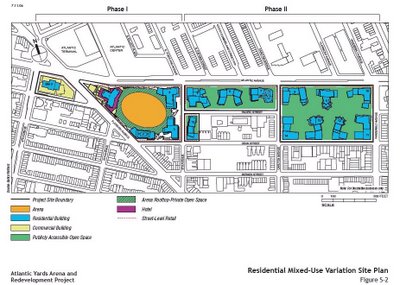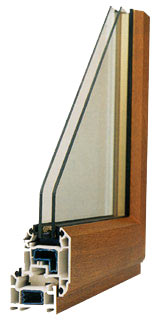Let's say you live on Dean Street or Carlton Avenue near the proposed Atlantic Yards project. The construction of a ridge of towers nearby would be quite noisy, and so would the future traffic, as the Draft Environmental Impact Statement (DEIS) issued by the Empire State Development Corporation (ESDC) acknowledges.
 The solution: batten down the hatches. And if you don't have double-glazed windows and air conditioning, Forest City Ratner will buy them for you.
The solution: batten down the hatches. And if you don't have double-glazed windows and air conditioning, Forest City Ratner will buy them for you.
The only problem: you have to stay inside.
The failure in that proposed mitigation is obvious not just to opponents and critics of Atlantic Yards, but even to Borough President Marty Markowitz, the project's biggest booster. Perhaps the Final Environmental Impact Statement will propose a better solution.
What the DEIS says
From Chapter 15 of the DEIS, covering Noise:
At most locations in the area where significant noise impacts are predicted to occur, most residences already have either double-glazed windows or storm windows, and many have some form of alternative ventilation (air conditioning). At all of the locations where significant noise impacts are predicted to occur the project sponsors would make these types of noise mitigation measures (i.e., storm windows and alternative ventilation) available, at no cost for purchase and installation, to owners of residences to the extent such measures are already not in place. These measures would mitigate project impacts for residential uses (see Chapter 19, "Mitigation"). At locations where owners elect not to take advantage of these mitigation measures, the proposed project would have unmitigated significant adverse impacts.
At all of the locations where significant noise impacts are predicted to occur the project sponsors would make these types of noise mitigation measures (i.e., storm windows and alternative ventilation) available, at no cost for purchase and installation, to owners of residences to the extent such measures are already not in place. These measures would mitigate project impacts for residential uses (see Chapter 19, "Mitigation"). At locations where owners elect not to take advantage of these mitigation measures, the proposed project would have unmitigated significant adverse impacts.
Marty disagrees
Borough President Marty Markowitz:
The FEIS [Final EIS] should acknowledge that the measure intended to mitigate noise and air quality problems during construction – providing double-paned windows and air conditioners for residents and community facilities – is not a solution for these problems, only a way to mask them while residents are inside their homes. The FEIS should recommend further mitigation methods so that these impacts are lessened in outdoor spaces.
An outraged neighbor
 Boerum Hill resident Anders Thomsen:
Boerum Hill resident Anders Thomsen:
The fact is that the DEIS does not provide any viable reroute of traffic. Instead the mitigations include installation of storm windows and a/c units for affected residents. First of all, this is making mockery of the affected residents. Are they no longer to have a conversation on their stoop outside their own house? The NYC noise code clearly states that we, the residents, have the right to enjoyment of our property (whether rented or owned) free of intrusive and excessive noise.
By offering storm window and A/C units to affected residents, the DEIS indirectly admits that the stoop facing the streets will be encroached upon by excessive and permanent noise pollution as a result of the project. Building the project will prevent people from sitting on their stoops and the face of Brooklyn will permanently be altered. That is unacceptable.
An expert's observation
Lehman College professor emerita Arline Bronzaft, in comments for the Council of Brooklyn Neighborhoods, said:
The DEIS downplays the significant impacts of Project-related noise in residences, with the statement that “most residences already have double-glazed windows or storm windows, and may have some form of alternative ventilation.” If air conditioning and double glazed windows are not in place, consultants note that the Developer would make these available to owners at no cost for purchase and installation.
They do not offer to compensate residents for the cost of running air conditioning for the sole purpose of noise mitigation. Given that accepting the proffered mitigation will obligate residents to an ongoing and perhaps unexpected expense, it is very possible some will not accept the material required by the mitigation.
In this event the DEIS draft consultants state that the proposed project would have “unmitigated significant adverse impacts.” This conclusion does not go far enough. It is improper to characterize an obligatory expense being transferred to local residents as mitigation. Therefore, the DEIS has not proposed any significant mitigation and the condition of construction related and ongoing Project related noise remains an unmitigated negative impact for an unknown percentage of the population.
The consultants believe that by sealing people in their homes, the expected significant noise impacts will not impact upon them. This assumes that people will agree to be sealed into their homes. In cooler temperatures, people do open up windows and individuals have this right; even in warmer temperatures, individuals may wish to open their windows. People also stroll the streets near their homes.
A residence extends beyond the apartment or the house; it includes the surrounding neighborhood areas as well. The proposed mitigation would undermine Brooklyn’s well-known “stoop culture,” condemning everyone who chose to meet with friends and neighbors on the block to adverse health risks. It would also undermine any benefits there might be to the network of “publicly accessible open space” planned for the project.
On the one hand the plan promises more than seven acres of public open space and then tells residents to stay in their apartments with their windows shut.
 The solution: batten down the hatches. And if you don't have double-glazed windows and air conditioning, Forest City Ratner will buy them for you.
The solution: batten down the hatches. And if you don't have double-glazed windows and air conditioning, Forest City Ratner will buy them for you.The only problem: you have to stay inside.
The failure in that proposed mitigation is obvious not just to opponents and critics of Atlantic Yards, but even to Borough President Marty Markowitz, the project's biggest booster. Perhaps the Final Environmental Impact Statement will propose a better solution.
What the DEIS says
From Chapter 15 of the DEIS, covering Noise:
At most locations in the area where significant noise impacts are predicted to occur, most residences already have either double-glazed windows or storm windows, and many have some form of alternative ventilation (air conditioning).
 At all of the locations where significant noise impacts are predicted to occur the project sponsors would make these types of noise mitigation measures (i.e., storm windows and alternative ventilation) available, at no cost for purchase and installation, to owners of residences to the extent such measures are already not in place. These measures would mitigate project impacts for residential uses (see Chapter 19, "Mitigation"). At locations where owners elect not to take advantage of these mitigation measures, the proposed project would have unmitigated significant adverse impacts.
At all of the locations where significant noise impacts are predicted to occur the project sponsors would make these types of noise mitigation measures (i.e., storm windows and alternative ventilation) available, at no cost for purchase and installation, to owners of residences to the extent such measures are already not in place. These measures would mitigate project impacts for residential uses (see Chapter 19, "Mitigation"). At locations where owners elect not to take advantage of these mitigation measures, the proposed project would have unmitigated significant adverse impacts.Marty disagrees
Borough President Marty Markowitz:
The FEIS [Final EIS] should acknowledge that the measure intended to mitigate noise and air quality problems during construction – providing double-paned windows and air conditioners for residents and community facilities – is not a solution for these problems, only a way to mask them while residents are inside their homes. The FEIS should recommend further mitigation methods so that these impacts are lessened in outdoor spaces.
An outraged neighbor
 Boerum Hill resident Anders Thomsen:
Boerum Hill resident Anders Thomsen:The fact is that the DEIS does not provide any viable reroute of traffic. Instead the mitigations include installation of storm windows and a/c units for affected residents. First of all, this is making mockery of the affected residents. Are they no longer to have a conversation on their stoop outside their own house? The NYC noise code clearly states that we, the residents, have the right to enjoyment of our property (whether rented or owned) free of intrusive and excessive noise.
By offering storm window and A/C units to affected residents, the DEIS indirectly admits that the stoop facing the streets will be encroached upon by excessive and permanent noise pollution as a result of the project. Building the project will prevent people from sitting on their stoops and the face of Brooklyn will permanently be altered. That is unacceptable.
An expert's observation
Lehman College professor emerita Arline Bronzaft, in comments for the Council of Brooklyn Neighborhoods, said:
The DEIS downplays the significant impacts of Project-related noise in residences, with the statement that “most residences already have double-glazed windows or storm windows, and may have some form of alternative ventilation.” If air conditioning and double glazed windows are not in place, consultants note that the Developer would make these available to owners at no cost for purchase and installation.
They do not offer to compensate residents for the cost of running air conditioning for the sole purpose of noise mitigation. Given that accepting the proffered mitigation will obligate residents to an ongoing and perhaps unexpected expense, it is very possible some will not accept the material required by the mitigation.
In this event the DEIS draft consultants state that the proposed project would have “unmitigated significant adverse impacts.” This conclusion does not go far enough. It is improper to characterize an obligatory expense being transferred to local residents as mitigation. Therefore, the DEIS has not proposed any significant mitigation and the condition of construction related and ongoing Project related noise remains an unmitigated negative impact for an unknown percentage of the population.
The consultants believe that by sealing people in their homes, the expected significant noise impacts will not impact upon them. This assumes that people will agree to be sealed into their homes. In cooler temperatures, people do open up windows and individuals have this right; even in warmer temperatures, individuals may wish to open their windows. People also stroll the streets near their homes.
A residence extends beyond the apartment or the house; it includes the surrounding neighborhood areas as well. The proposed mitigation would undermine Brooklyn’s well-known “stoop culture,” condemning everyone who chose to meet with friends and neighbors on the block to adverse health risks. It would also undermine any benefits there might be to the network of “publicly accessible open space” planned for the project.
On the one hand the plan promises more than seven acres of public open space and then tells residents to stay in their apartments with their windows shut.
Comments
Post a Comment